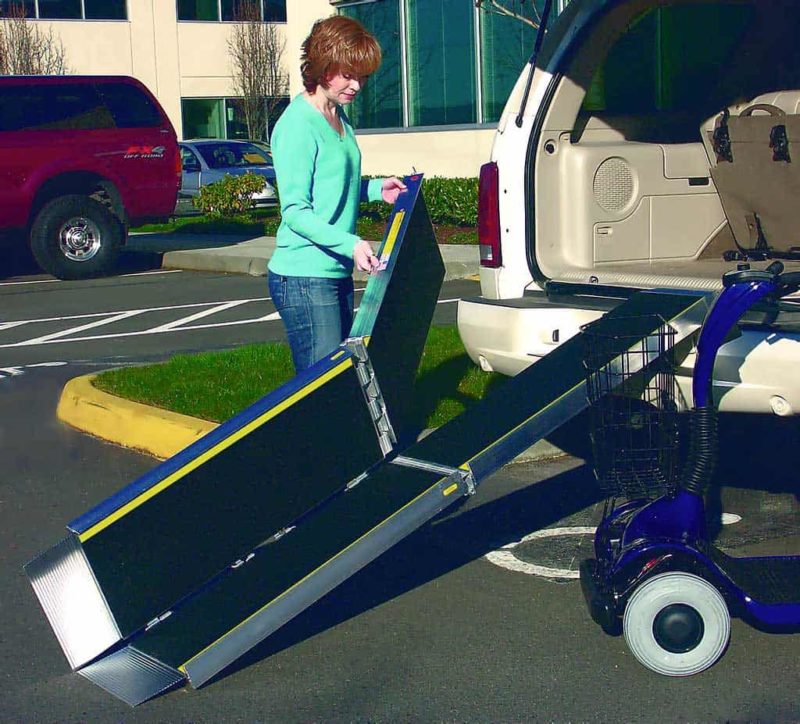Increasing accessibility around your home or dwelling may come down to ramps. If you wonder when it is time to consider portable mobility ramps, the time could be now. Talk to a mobility expert to find portable ramps – as well as other aids – to increase access and preserve autonomy.
Investing in mobility devices is a big decision with life-changing consequences, so when it it time to consider portable mobility ramps? The simple fact that you are asking yourself that question could point toward it being time to discuss your options with a mobility expert. Portable ramps are the perfect first-step in increasing access, safety, and independence in the home – as well as when you leave the house! Consider the many benefits of something so basic and ask yourself what you are waiting for.
Got questions about ramps and mobility aids? Here are some answers for you:
When is it time to consider portable mobility ramps?
It is estimated that more than 15 million people use some kind of an assistive device, including ramps. Among these individuals are over nine-million people over age 65; since nobody is getting any younger, doesn’t it make sense that now is the time to think about installing ramps? Ramps offer assistance to a wide range of users, from those utilizing other mobility equipment like scooters or wheelchairs to those who walk without support but that want a gentler way of obtaining access to areas around their home.
How do ramps help?
The argument for ramps comes down to increased access equates to improved autonomy; simple. Ramps provide a low-rise incline to assist consumers to navigate stairs, risers, steps, and elevated areas, while also providing a key tool in managing and transporting any existing medical or mobility equipment. When you shop for a scooter or chair, you may also be looking for ramps, however, even if you don’t use these devices, a ramp may be the little extra assistance you need to prevent discomfort, a nasty fall, or a subsequent injury.
What are the options?
You have ample options when it comes to ramps; some of the most common and relied-upon include threshold ramps, folding ramps, and modular ramp systems. While retailers can discuss these options in more depth, threshold and modular ramps are typically permanent fixtures. Folding ramps offer portability, which could make them more affordable and multi-functional for some consumers.
Does a portable ramp make sense?
The reason why portable ramps make sense comes down to convenience. A portable or folding ramp offers a wide-range of opportunities to use, from getting in and out of vehicles to easily entering your home. Furthermore, portable ramps offer occasional utility or could be implemented as a permanent feature of your property. Talk to mobility retailers about folding ramps, including tri-folds, for easiest storage and operation on-the-go.
What do buyers need to know?
Distinct needs require distinguished solutions; make sure that the ramp you buy offers versatility and convenience. Portable ramps allow freedom of access that may not be found with other types, but with this comes specific usage recommendations that may – or may not – meet your current and future needs. The best approach is to speak with an expert in mobility devices for a thorough needs assessment.
How do you stay safe?
The best way to ensure performance and satisfaction of any mobility aid or device is to follow the recommended usage and safety tips provided by the manufacturer and seller. However, there are some basic strategies that can curb accidents and maintain your ramp during use that merit attention.
Some tips to stay safe include:
- To ensure your ramp is at a safe degree of incline, aim for one-foot of ramp per one-inch of incline.
- Keep your ramp maintained in inclement weather to avoid slips or falls and provide some sort of traction during precipitation. Vendors may have grips or recommended strategies to keep the ramp traversable.
- Keep the landings on both ends of your ramp as flat and level as you can.
- Always pay attention to the weight restrictions for your ramp; this includes the weight of any devices, aids, or items that you may routinely carry on your ramp.
What next?
The next step should be to reach out and speak with a mobility expert in your area. They can reinforce why professional installation is key, and why it is integral to only allow qualified mobility technicians install, service, or repair your equipment. While portable ramps are easy-enough for the layman to implement and utilize, your mobility merchant can point out usage tips, manufacturer’s recommendations, and safety suggestions to ensure satisfaction over the long-term.
If you are wondering when the time for ramps is or other mobility aids, it could be now. Take time to discuss options, benefits, and costs with a mobility professional, and see for yourself how much convenience and autonomy a simple, portable ramp can bring to your lifestyle. Got questions about mobility options? Keep these answers in mind and speak with an expert today!
President, Husband, Father, Grandfather Graduate of UC Davis- Bio Sci Major- Go Aggies! Jeff has extensive experience in all of Pacific Mobility’s products and services, and specializes in accessibility products as well as stairlifts, ceiling lifts and custom wheel chairs. His hobbies include spending time with family, gardening, mountain biking, exercising and off road motorcycle riding.
24 years as Owner/President of Pacific Mobility Center – selling, installing, and servicing stairlifts, porch lifts, ceiling lifts, pool lifts, handicap ramping, specialty wheelchairs, scooters, power wheel chairs, and other power mobility devices
Certified Environmental Access Consultant since 2008
Licensed General Contractor since 1998
Certified Aging in Place Specialist since 2016
Board Member for Home Access Professionals
Member of Association of Members of the Accessibility Equipment Industry (AEMA)




